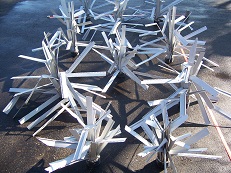Price: $350.00
SKU: oas-6
Weight: 142.00 LBS
Rating: ( 1 product review )
Shipping: Free Shipping
Quantity: 
Product Description
Here is what you have been asking for! A substanial addition to any habitat plans, this deeper water structure group, has room for all ages and sizes of fish.
With three each of the Keeper and Safehouse, this resting area provides a total of 318 square feet of surface area.
The right amount of cover to create room for fish to rest and feed in the same location.
These six units will cover an area between 20×10 feet, or a line over 30 feet long.
Experiment with different layouts with each additional refuge you install.
Keeper
Maximum shade and protection is abundant throughout this eco. friendly product made with reclaimed pvc material. With limbs all standing a full 48″, these 2-1/2″-3-1/2″ wide surfaces grow algae and aquatic life quickly.
Each keeper weighs approx. 32 pounds, and is recommended for depths over 10 feet. This large and somewhat coarse cover, provides habitat for all sizes of fish.
Bass,crappie,panfish alike utilize the shading effects of this new type of artificial fish attractor. Go-green and promote fish habitat restoration! Made in the USA with all American made materials.
Reclaimed pvc limbs provide an eco.-friendly solution to fish habitat loss and degradation.
Safehouse
These safehouse fish habitat units stand 46″ tall and weigh 16 pounds each. This fish attractor has all the needed shade and coverage to hold all sizes of fish.
Consisting of limbs ranging in width from 2.5″-3.5″ wide and 18″-46″ tall, they open to a full 72″ wide. With a minimum of 44 square feet of surface area, it provides plenty of room for algae and shade to attract fish.
Recommended for depths of 6′-12′. Reclaimed pvc limbs provide an eco.-friendly solution to fish habitat loss and degradation.
Bend to shape by hand to any desired shape and toss in water. Sinks itself. Made in the USA with all American made materials.
Over 44 square feet surface area each.
Find Similar Products by Category
Artificial Fish Structures
Product Reviews
perfect price and size
Posted by Unknown on 27th Apr 2011
thanks for adding this group of structure. i alraedy bought two keepers and they work good.Will be ordering more of these groups sonn.
Customers Who Viewed This Product Also Viewed
“Cradle” Artificial Fish Habitat
$60.00
Add To Cart
“Safehouse” Artificial Fish Habitat
$55.00
Add To Cart
Artificial fish habitat “Starter Pack”
$675.00
Add To Cart
“Keeper Four Pack” Artificial Fish Habitat
$260.00
Add To Cart
Our Newsletter
Your First Name:Your Email Address:
Add to Wish List
Click the button below to add the “The Refuge” 6-pack artificial fish habitat structures and attractors to your wish list.
Related Products
“Bassinet” Artificial Fish Habitat
$30.00
“Keeper” Artificial Fish Habitat
$70.00
“Nursery” Artificial Fish Habitat
$30.00
“Playground”Artificial Fish Habitat
$30.00
“Safehouse” Artificial Fish Habitat
$55.00
You Recently Viewed…
“Keeper” Artificial Fish Habitat
$70.00
Add To Cart
“New 8″ Cradle” Four Pack fry fish habitat
$210.00
Add To Cart
“The Refuge” 6-pack artificial fish habitat structures and attractors
$350.00
Add To Cart
“Keeper Four Pack” Artificial Fish Habitat
$260.00
Add To Cart
“Triplet” Artificial Fish Habitat-3 pack
$75.00
Add To Cart